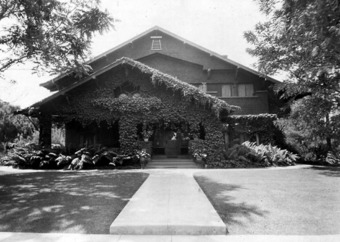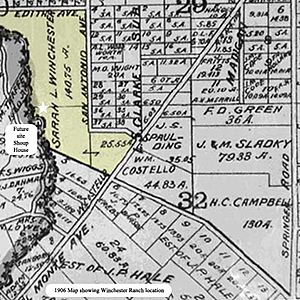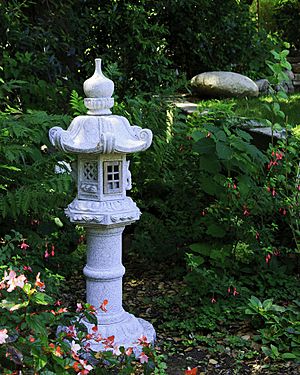Paul Shoup House facts for kids
|
Paul Shoup House
|
|

Paul Shoup House circa 1920
|
|
| Location | 500 University Avenue, Los Altos, California |
|---|---|
| Area | 0.6 acres (0.24 ha) |
| Built | 1910 |
| Architect | Charles McKenzie |
| Architectural style | American Craftsman |
| NRHP reference No. | 11000696 |
Quick facts for kids Significant dates |
|
| Additions | Circa 1925, 1990 |
| Lot subdivided | 1980, 2000 |
| Rehabilitated | November 2010 |
| Added to NRHP | September 23, 2011 |
The Paul Shoup House is a special old home in Los Altos, Santa Clara County, California. It was built in 1910 for a man named Paul Shoup. The house is designed in the American Craftsman and Shingle styles, which means it uses natural materials like wood shingles and has a cozy, handcrafted look.
In 2011, the Paul Shoup House became a historic site listed on the National Register of Historic Places. This was a big deal because it was the very first building in Los Altos to get this important recognition!
Contents
About the House and Its Design
The Paul Shoup House is a two-story home built in 1910. It sits on a large piece of land that was once part of a bigger property. The house is made with wood shingles, giving it a unique look.
Even after more than 100 years, the house still has many of its original wooden windows and decorations. You can see special wooden brackets, bell eaves, and cool vents. The outside also has old concrete walls and a stone grotto (a small cave-like structure).
Inside, the house still has its original front door, an old Venetian light, and beautiful Douglas fir wood floors. The wood paneling, beams, and fireplace mantels are also original. Even the door and window frames, and the brass handles, are from when the house was first built.
Who Lived Here?
Paul Shoup (1874–1946) was a very important person. He was the president of the Southern Pacific Railroad in the 1920s and 1930s. He also helped start the Stanford University School of Business. Paul Shoup is also known for founding the community of Los Altos itself!
Paul's son, Carl Sumner Shoup, grew up in this house. Imagine riding your horse to school every day, just like Carl did! Carl became a famous economist (someone who studies money and how countries use it) at Columbia University. He came up with the idea for the "value-added tax" (VAT), which is a type of sales tax used in many countries today. After World War II, Carl helped Japan fix its economy by suggesting this tax idea to their government.
Another person connected to the house was Bunichi Kagawa. He was the son of Shoichi Kagawa, who was the garden caretaker for the Shoup family. Bunichi became a writer and poet. He wrote poems in both Japanese and English, and his collection of poems, Hidden Flame, was published in 1930.
Restoring and Celebrating the House
Bringing the House Back to Life
The city approved a plan to restore the Paul Shoup House. This work was finished just in time for the house's 100th birthday! Inside, the house was updated to be safe from earthquakes and to have modern plumbing and electricity. Old parts like the kitchen and bathrooms were made new, but in a way that fit the house's original style. Lead paint was removed, and the wood was stained to match its original look.
The garden was also redesigned. It was made to look like a traditional Japanese garden from the 1920s. They used special plants and stone work to create beautiful terraces.
A Big Birthday Party
After the house was restored, the Jennings family, who owned the house at the time, hosted a big party. It was a "centennial celebration" (a 100-year celebration) to help the Los Altos History Museum. Many members of the Shoup and Kagawa families came to the party. They shared stories about visiting the house and living there. People even came from far away, like Europe, to join the celebration!
Special Garden Dedications
The Los Altos History Museum and the homeowners honored Rose Wilson Shoup, Paul Shoup's wife. They dedicated a rose garden to her, calling her the original "Mother of Los Altos."
In May 2011, a historic grotto (a small, decorative cave) near Adobe Creek was dedicated to Shoichi Kagawa. He was the main gardener and caretaker of the Japanese garden. He and his family lived on the property for many years. Sadly, they were sent to the Heart Mountain camp during World War II, as part of the Japanese American internment.
Why the House is Important
The homeowners, Bill and Tricia Jennings, worked hard to get the Paul Shoup House listed on the National Register of Historic Places. They got help from an architecture firm. Their application was successful, and the house was officially added to the list on September 23, 2011. This made it the first property in Los Altos to receive this special honor! The house was recognized because of how important its original owner, Paul Shoup, was to the area.




